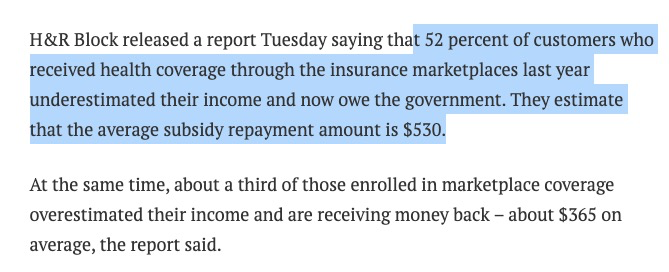
📣 NEW: PREPARE THYSELF: It may be in fits & starts, but #ACA2.0 *is* happening:
acasignups.net/21/03/15/prepa…
acasignups.net/21/03/15/prepa…
Four years ago I posted my (now sorely outdated) list of 20 changes to the #ACA I'd make If I Ran The Zoo (yes, I understand how awkward that title is at the moment): acasignups.net/18/02/12/updat…
In January, Sen. @MarkWarner introduced his Health Care Improvement Act which includes many of the same provisions: warner.senate.gov/public/index.c…
In February, @SenatorBennet & Sen. @TimKaine re-introduced their Medicare X bill...which includes many of the same provisions: bennet.senate.gov/public/index.c…
And last week, via @AmyLotven, @SenatorShaheen introduced her Improving Health Care Affordability Act: shaheen.senate.gov/news/press/sha…
Over the past few years there've been several other variants of these bills as well, such as Sen. @EWarren's Consumer Health Insurance Protection Act... warren.senate.gov/newsroom/press…
...@SenJeffMerkley & Sen. @ChrisMurphyCT's "Choose Medicare act... merkley.senate.gov/news/press-rel…
...and of course, my PERSONAL favorite, Rep. @RosaDeLauro & @RepSchakowsky's "Medicare for America" Act: acasignups.net/20/04/10/reall…
HOWEVER, of all of these (and several others), I suspect that the bill most likely to actually get passed through the House *and* Senate over the next 2 years is @SenatorShaheen's just-introduced #S499: The Improving Health Care Affordability Act.
#S499 is similar to @RepUnderwood's #H369: It doesn't tackle everything on the #ACA2.0 wish list at once, but what it DOES do is vitally important:
1. *Permanently* #KillTheCliff
2. *Permanently* #UpTheSubs
3. Upgrade #SilverToGold
4. Upgrade #CSRto400
5. Formally *fund* #CSR
1. *Permanently* #KillTheCliff
2. *Permanently* #UpTheSubs
3. Upgrade #SilverToGold
4. Upgrade #CSRto400
5. Formally *fund* #CSR
The best part about #S499 is that the first four items would be mostly FUNDED by...the fifth.
That's right: It would fund CSR payments which would, ironically, SAVE $200 BILLION+ DOLLARS over the next decade. Which would in turn be used to mostly pay for the beefed-up subsidies.
That's right: It would fund CSR payments which would, ironically, SAVE $200 BILLION+ DOLLARS over the next decade. Which would in turn be used to mostly pay for the beefed-up subsidies.
As @amylotven notes, this would bring #SilverLoading to an end...but that's OK. Silver Loading mainly serves as an hoc, partial solution to the same issues.
I've promoted Silver Loading for years, but if this bill is passed, it'd no longer be necessary.
insidehealthpolicy.com/daily-news/sen…
I've promoted Silver Loading for years, but if this bill is passed, it'd no longer be necessary.
insidehealthpolicy.com/daily-news/sen…
Honestly, of all the wish list items which AREN'T included in #S499, the only one which I really wish it had included is fixing the #FamilyGlitch. It'd open #ACA subsidies to several million more people who were supposed to be eligible in the first place.
• • •
Missing some Tweet in this thread? You can try to
force a refresh








